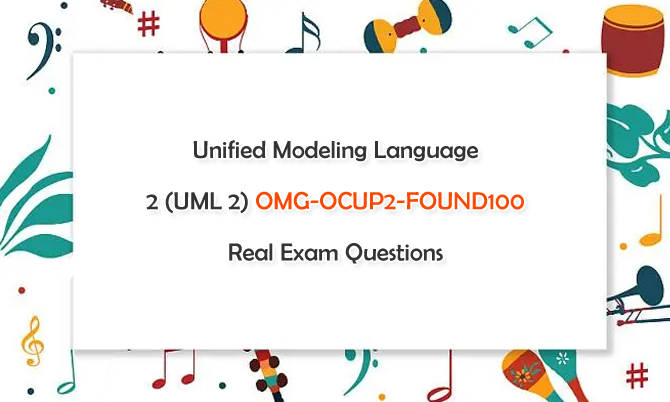Obtaining OMG Certified UML Professional 2 (OCUP 2) - Foundation Level certification can validate your expertise and open doors to new opportunities. The OMG-OCUP2-FOUND100 exam serves as the foundation level for the OCUP 2 certification program. It assesses an individual's knowledge of essential UML concepts and their practical application in real-world scenarios. Candidates are evaluated on their comprehension of various UML diagram types, as well as their understanding of why software modeling is essential in different domains.

The OMG-OCUP2-FOUND100 exam is available in both English and Japanese. The OMG-OCUP2-FOUND100 exam consists of multiple-choice questions, including both text and image-based items. The passing score for the exam is set at 60/90 correct answers or 67% overall. Candidates have either 120 minutes (in native English-speaking countries) or 150 minutes (in all others) to complete the exam, with additional time provided upon request after completing the exam order. Candidates must demonstrate their proficiency in several key areas, with the following distribution of topics:
Class Diagrams (25%): Essential for illustrating the structure of a system by depicting classes, attributes, operations, and relationships.
Activity Diagrams (20%): Used to model the flow of actions or activities within a system, showcasing the sequence and conditions of processes.
Sequence Diagrams (15%): Depict the interaction between objects in a sequential manner, offering insights into the dynamic behavior of the system.
Why We Model (15%): Explores the rationale behind software modeling, emphasizing its significance in different domains and the benefits it brings.
State Machine Diagrams (10%): Capture the behavior of objects through various states and transitions, aiding in the representation of system logic.
Object Diagrams (5%): Provide a snapshot of the relationships between objects at a particular point in time, aiding in understanding system structure.
Package Diagrams (5%): Organize and structure the elements of a system into cohesive units, facilitating modular design.
Use Diagrams (5%): Illustrate the interactions between actors and the system, elucidating the system's functionality from a user's perspective.
For candidates to truly excel and achieve outstanding results in the OMG-OCUP2-FOUND100 exam, it is of paramount importance that they dedicate considerable time and effort to thoroughly study each and every topic outlined in the detailed exam syllabus. Resources such as comprehensive textbooks, interactive online courses, and carefully crafted practice exams can provide invaluable insights into the subject matter and help to reinforce understanding of complex concepts.
OMG-OCUP2-FOUND100 real exam questions can also help to highlight any areas of weakness that need further study. Furthermore, obtaining hands-on experience with UML modeling tools can greatly enhance practical skills, providing candidates with the opportunity to apply theoretical knowledge to practical scenarios. This can significantly increase their confidence in interpreting, understanding, and creating complex UML diagrams, which is a critical component of the exam.
Share some OMG-OCUP2-FOUND100 real exam questions and answers below.
1. What is the best reason that projects take on the extra work of making models?
A. Modeling makes it appear that you are making progress.
B. Management requires modeling.
C. Modeling reduces the risk of system development.
D. Modeling can help in code generation.
Answer: C
2. If a project is using a structured decomposition approach to development, how should UML be used?
A. Don’t use UML. It is only for object-oriented approaches.
B. Use the structured decomposition approach during analysis using DF/CF diagrams and switch to an object-oriented approach during design and implementation using UML.
C. Use fUML for the functional parts and UML for the object-oriented parts.
D. There is no problem in using UML for everything.
Answer: D
3. For what type of systems is UML primarily intended?
A. Software-intensive systems
B. Systems Engineering systems
C. Business systems
D. Interactive systems
E. Mechanical/Analog systems
F. Collaborating Smart Phone Apps
Answer: A
4. Which of the following statements is true about UML State Machines?
A. Every State must have possible transitions in and possible transitions out.
B. Every State Machine diagram must have a final state.
C. The star-shaped state indicates concurrency.
D. Every transition is from one state to another different state.
E. A completion transition is triggered by the completion of the activity within its state.
Answer: E
5. A large X is used to accomplish what purpose in a Sequence Diagram?
A. X is the graphical end of the lifeline.
B. X indicates the destruction of the lifeline.
C. X marks the spot.
D. X marks where to dig.
E. X marks the start of a balking message.
F. X marks the start of a timed message.
Answer: B
Obtaining the OMG-OCUP2-FOUND100 certification signifies a solid foundation in UML, making you a valuable asset to any software development team. Whether you're aiming to interpret UML diagrams with precision or contribute as a model builder, this certification opens doors to new career opportunities and validates your expertise in UML fundamentals. By investing time and effort in preparation, you can confidently approach the exam and take the first step towards becoming an OMG Certified UML Professional 2.